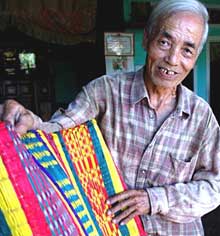To visit Ban Thach Mat Market in Duy Vinh Commune, Duy Xuyen District of Quang Nam Province when the first sunshine is emerging over the horizon. It is the sole mat market in the Province that still exists until now.
People get up early in the morning to get to the market before the major rush happens between 5 and 6am. The market is open every morning and closes at about 9 am. Rush mats are transported from neighbouring communes such as Duy Vinh, Duy Phuoc, Duy Thanh and Duy Nghia. The sellers are people coming from households engaged in weaving mats, or traders who buy mats from families and wholesalers.

Nguyen Van Tri, a mat-weaving artisan
Traders buy mats from the mat-weaving families and sell them at the market, earning a profit of VND 1,000 per mat. If the weavers sell their mats at the market they can earn more. Those who have their houses near the market buy mats and send to other areas. Some people from Da Nang or other places come to Ban Thach Village to buy mats and hire trucks to transport the mats to distribute to retailers. There are street vendors who transport mats by bicycles to alleys and side streets to sell to customers. Each trader earns a profit of only VND 1,000 to 3,000 a mat. Normally, two people can weave three or four mats a day and each of them earns about VND 20,000.
Mats are transported to Ban Thach Market by all means, carried by people, bicycles and boats, and from this market, they are transported to many parts of the country. Each day about 5,000-8,000 mats are traded at Ban Thach Market. Apart from mats, many utensils for family use are also sold.
An Phuoc Village in Duy Phuoc Commune, Quang Nam Province has been known for its craft of making mats. The villagers can weave high-grade mats using a complex technique that no other localities employ.
 |
| Nguyen Van Tri, a mat-weaving artisan |
Nguyen Van Tri, a 73-year-old artisan said that the mat-weaving was a hereditary craft of his family. Initially, they produced simple mats and later, they produced mats with printed patterns and embossed designs.
Mats with embossed designs are made by weaving the rush fibres into scripts and pictures that the weavers relate to. In the past, the artisans used to weave the Buddha Swastika, the sign of happiness and simply golden strips. Today they weave complicated images, such as the renowned Cau Pagoda in Hoi An. Thanks to the skilful hands of the craftswomen, the mats looks like a lively picture. The mat-weaving requires much time and efforts of the weavers who have to select the fibres and check each colour on the loom. There are many people engaged in weaving mats in Thach Ban Village but only several people with skilful hands and experience can weave embossed scripts and scenes.
An Phuoc Village (now My Phuoc Village) has been recognised as a traditional craft village by Quang Nam provincial authority. Duy Phuoc Commune is actively carrying out a project on restoring and developing the craft village to make it a mat-producing area a tourist site as well.
An Phuoc Village has 240 households engaging in making mats. It has a population of 1,066 people, of whom 401 people follow their forefather’s craft. In the future An Phuoc Village will be added to the travel book of foreigners, together with interesting destinations, such as Thanh Ha Ceremic Village, Tra Que Vegetable Village and Kim Bon Carpentry Village in Hoi An. Visitors can place orders for rush mats with their own designs. In addition to the traditional products, people in this area will produce souvenir items made of bamboo, rush and jute.
Hopefully, an economy of tourism, trade and services will turn this poor area into an affluent city in the future.
 |
| The mat weaver selects rush and jute |